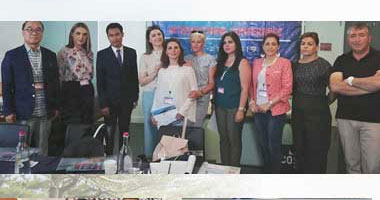Ecolab Helps Businesses Manage Water Risk with Azure Technology

Christophe Beck, EVP & President, Nalco Water,
Ecolab Inc.
At Ecolab, we have a powerful purpose: to make the world cleaner, safer and healthier by protecting people and vital resources. We are guided by our vision to provide and protect clean water, safe food, abundant energy and healthy environments. In partnership with our customers, we have set an ambitious goal to help conserve enough water annually in our customers’ and our own operations to equal the drinking needs of more than 1 billion people by 2030, which equates to 300 billion gallons of water per year.
Every day, we are working on the ground alongside our customers at more than 1 million locations, helping them identify risks and turn them into opportunities to do more using less water. We know that smarter water management, when done right, can transform business. Using less water can also result in producing better products, with improved productivity, reduced waste and better returns.
It is our job and our mission to help companies manage their business smarter, and in turn, we are always on the lookout for ways to make Ecolab smarter for our clients. We’ve partnered with two other companies to do just that. In collaboration with Microsoft and Trucost, a global leader in environmental data and risk analysis and part of S&P Dow Jones Indices, we recently introduced enhancements to the Water Risk Monetizer, industry’s first publicly available financial modeling tool that enables businesses to factor current and future water risks into decision making.
In March 2017, we incorporated a new water quality analysis into the tool to provide a more holistic business risk assessment. The tool leverages industry insights, advanced analytics and Azure Cloud technology to help business leaders easily access information to better understand the impacts of water scarcity.
The level of global water scarcity expected in coming years is a function of the compounding impacts of decreasing availability and declining quality, and both factors are now incorporated into the Water Risk Monetizer risk assessment.
The Water Risk Monetizer quantifies the full value of incoming and outgoing water to a specific location based on basin-level quantity and quality considerations - taking into account tangible factors such as scarcity and impairments as well as less tangible human, health and environmental impacts of water use. This information can help businesses more effectively make the case for investments in water-saving technologies and solutions.
Here’s one example. Through a partnership with Nalco Water, Microsoft implemented a water efficiency and quality plan at its San Antonio, Texas, data center that helped reduce overall operating costs and optimize water usage. The Water Risk Monetizer outputs modeled risk adjusted water cost savings equivalent to nearly $800,000 annually and helped demonstrate the full value of water to Microsoft’s operations, supporting a continued and proactive water stewardship strategy for quality and quantity investments. Nalco Water is now partnering with Microsoft across their data centers to leverage smart water management practices and advanced analytics to increase operational resilience and reliability
The tool also provides a new level of enterprise risk analysis by ranking facilities based on risk level and plotting facilities on a risk versus likelihood continuum to make it easier to prioritize action.
And these improvements to the Water Risk Monetizer are just the beginning of where we are headed. We are on the cusp of the Fourth Industrial Revolution - where a fusion of technologies is blurring the lines between the physical, digital and biological worlds. As in all revolutions, it’s not really about doing the same things better. It’s about transformation. Technology and data are enabling a transformation of the way we manage water and there is real value leveraging the data and insights delivered through advanced, connected technology to change the way we think and act.
Technology offers us an opportunity to rethink the water cycle: to shift our understanding and practices away from water as a consumable good toward water as a recyclable asset. And technology is allowing us to also rethink HOW we do this. We need to leverage digital capabilities to turn the mass amounts of data available to us today into meaningful and usable business insights that can inform our strategies and transform our businesses.
Through IoT, cloud and data analytics, we can monitor water processes in real time to identify risks and opportunities for improved efficiency. The Water Risk Monetizer and other publicly available tools provide data on water risks to help us prioritize locations for action. Using a risk-adjusted water price, we can calculate and demonstrate a risk-based return on investment for water conservation and reuse projects. Then, once solutions are in place, continuous digital monitoring and measurement of performance helps us document the savings achieved and communicate results.
The business case for water management is a great one. With less water, businesses can get better results and lower operating costs. Businesses can grow to meet the world’s increasing demands - while ensuring water will be there for future generations. Businesses can also be good corporate citizens contributing to vital communities. Everyone wins. Less than three percent of wastewater is reused as a percentage of freshwater available on the planet today. What if that percentage doubled? Or tripled? It’s on all of us do our part to help drive this shift from water as a consumable good to water as a reusable asset. From conservation to reuse, technologies like the Azure Cloud are offering new and better ways to reduce water use in a way that is both good for business and for the planet.
Subscribe to Industry Era
News
This Apple Watch Case Could Kill All of Those Wannabe AI Devices
Google defends AI search results after they told us to put glue on pizza
Google scales back AI search answers after it told users to eat glue
FAA won't approve increased 737 Max production in near future
Thursday was a sour day for the US economy — with an important silver lining
OPEC+ working on complex production cut deal for 2024-2025, sources say
Stock futures inch lower as investors review earnings, brace for inflation report: Live updates
Salesforce Shares Plunge by Most Since 2008 After Weak Outlook
Jeep’s Wagoneer S Trailhawk concept teases a fully electric off-roader
Gap’s stock jumps 23% as the retailer swings to profit and raises guidance
Medline recalls 1.5 million bed rails linked to deaths of 2 women
Oil falls as Fed policymakers look to maintain rate cuts, gasoline stocks rise










